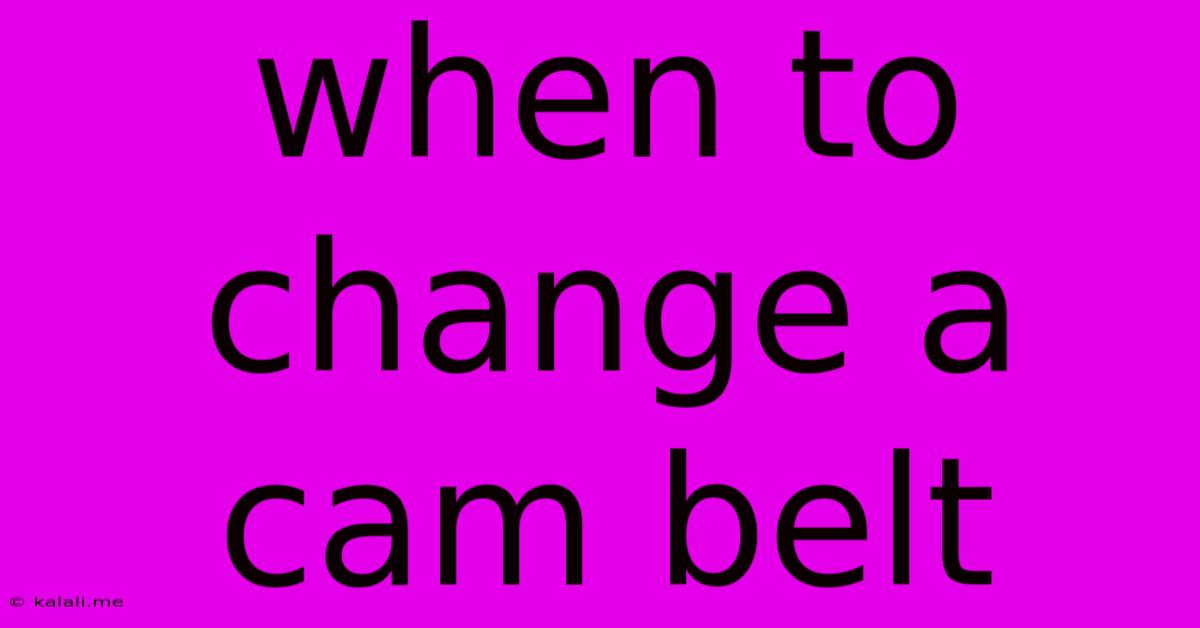When To Change A Cam Belt
Kalali
May 31, 2025 · 3 min read

Table of Contents
When to Change a Cam Belt: A Comprehensive Guide
Meta Description: Learn when to change your cam belt to avoid costly engine damage. This guide covers recommended intervals, warning signs, and the importance of regular maintenance for optimal engine performance.
Ignoring your cam belt can lead to catastrophic engine failure, a costly repair that could easily run into thousands of dollars. Understanding when to change your cam belt is crucial for maintaining your vehicle's health and avoiding unexpected breakdowns. This comprehensive guide will help you determine the right time to replace this vital component.
Understanding the Cam Belt's Role
The cam belt, also known as a timing belt, is a critical part of your engine's internal workings. It synchronizes the rotation of the crankshaft (which drives the pistons) and the camshaft (which controls the valves). If the cam belt breaks, the valves and pistons can collide, resulting in severe engine damage. This necessitates a complete engine rebuild or replacement, a far more expensive repair than a preventative cam belt change.
Recommended Replacement Intervals
The frequency of cam belt replacement varies considerably depending on the make, model, and engine type of your vehicle. Consult your vehicle's owner's manual for the manufacturer's recommended replacement interval. This is the single most important source of information for your specific car. Generally, intervals range from 60,000 to 100,000 miles (or 5 to 8 years), but some vehicles may require replacement sooner. Ignoring the manufacturer's recommendation significantly increases the risk of failure.
Warning Signs of a Failing Cam Belt
While a broken cam belt often happens without warning, there are some signs that might indicate it's nearing the end of its life:
- Unusual Noises: Listen for squealing, chirping, or knocking sounds from the engine, especially when starting or accelerating. These could indicate belt wear or tensioner problems.
- Visible Damage: Inspect the belt regularly for cracks, fraying, glazing, or any signs of wear and tear. Look for loose or missing teeth. A visual inspection is often best conducted by a qualified mechanic.
- Engine Misfires or Rough Running: If the engine is running poorly, misfiring, or idling roughly, it could be a sign of issues related to the timing system. This should warrant professional inspection.
Factors Affecting Cam Belt Lifespan
Several factors can influence how quickly a cam belt deteriorates:
- Driving Conditions: Harsh driving conditions, including frequent stop-and-go traffic, high speeds, and extreme temperatures, can accelerate wear.
- Maintenance: Proper engine maintenance, including regular oil changes, contributes to a longer cam belt lifespan.
- Belt Quality: The quality of the cam belt itself plays a role. Using a low-quality replacement belt will reduce its lifespan. Always choose a high-quality replacement from a reputable supplier.
The Importance of Preventive Maintenance
Replacing the cam belt before it fails is always the best approach. A preventative replacement is far cheaper than dealing with the consequences of a catastrophic failure. The cost of a new cam belt and labor is considerably less than the expense of an engine rebuild or replacement.
When in Doubt, Consult a Mechanic
If you're unsure when your cam belt needs replacing or if you notice any warning signs, it's crucial to consult a qualified mechanic. They can inspect your belt, assess its condition, and advise you on the best course of action. Don't gamble with your engine; proactive maintenance is always the best policy. Ignoring the need for a cam belt replacement can be a very costly mistake.
Latest Posts
Latest Posts
-
Sql Group By Month And Year
Jun 01, 2025
-
Mid 2012 Macbook Pro Ram Capacity
Jun 01, 2025
-
What Should The Pressure Be In A Well Pressure Tank
Jun 01, 2025
-
Why Did Morgan Leave Criminal Minds
Jun 01, 2025
-
How To Merge By Used Google Maps
Jun 01, 2025
Related Post
Thank you for visiting our website which covers about When To Change A Cam Belt . We hope the information provided has been useful to you. Feel free to contact us if you have any questions or need further assistance. See you next time and don't miss to bookmark.